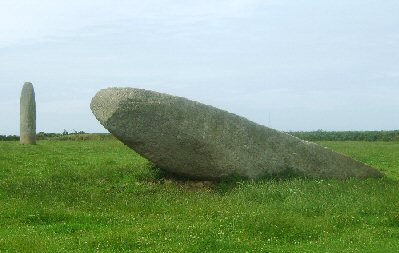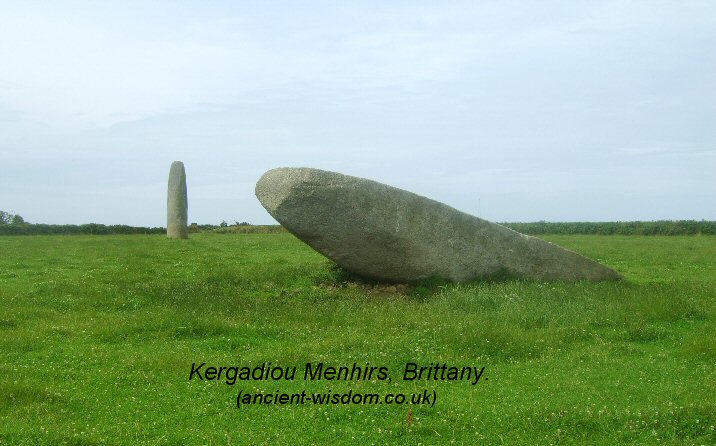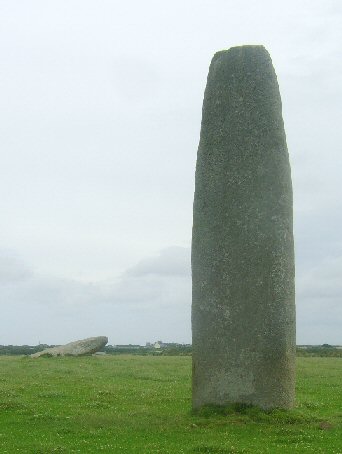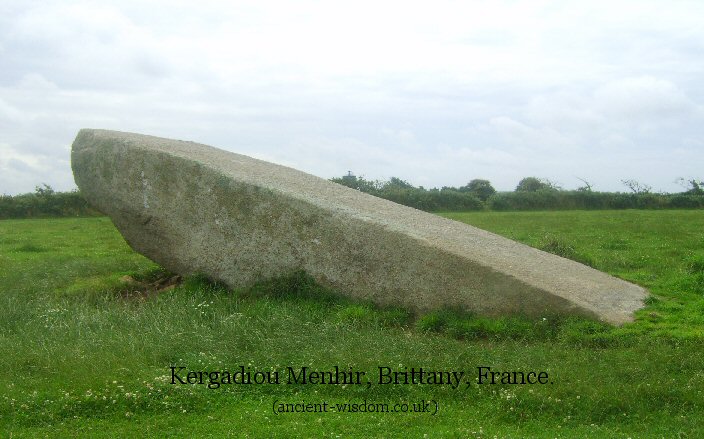|
Location:
Pleuron, France. |
Grid Reference:
48� 29' 36.9" N, 4� 43' 30" W |

 Kergadiou:
(Menhirs).
Kergadiou:
(Menhirs).
These
two beautifully carved menhirs demonstrate the high skill of the
Neolithic workforce who carved, transported and erected these two
majestic
menhirs.
The standing menhir is 8.75 meters high;
while the fallen one measures 11 meters. It is the second tallest in Brittany after that of Kerloas at
Plouarzel.
The Kergadiou menhirs are aligned to
coincide with the mid-summer solstice. There are several other
menhirs within close proximity to it, suggesting that it may have once
been an important part of the Neolithic landscape of Brittany.
(Map with location and other menhirs in
region)
These are two of the tallest menhirs
in Brittany. They are currently only seconded in size by Kerloas menhir
which is approximately 30km distant. Their phenomenal size suggests a
purpose behind their construction, an idea which may well have
foundation when the Brittany menhirs are looked upon as a whole. Many of
the most prominent Brittany (French), menhirs were placed in view of the
coastline and/or were visible from miles around.

The Kergadiou menhirs, near Plourin-Ploudalmezeau
in Brittany, France.
Both menhirs appear to have always had
flattened, rather than pointed tops. During
the Second World War, the Germans built a watchtower on the upright
menhir and were apparently able to see the English coast on sunny days.

From these two giant menhirs, it is
possible to see the Kerloas menhir (barring the modern tree-line), and the sightline over the Kerloas menhir is
apparently perpendicular to the
midsummer sunrise and therefore, the azimuth of the two stones
themselves, which if correct would mean that (when both standing), the
shadows of each stone should have fallen on to the other at midsummer's
sunrise and sunset.
(They are orientated on an azimuth of 215� SSW).

The upper surface of the fallen menhir
has been pummelled perfectly flat. Its extra 2m length testifies to the
suggestion that most
menhirs can be estimated to extend approximately 20% further underground.
It is suggested that the
flattened surface was carved after the menhir fell as the other menhir
doesn't have a flat face. While this seems reasonable logic, one has to
ask why?
Text from site plaque:
'According to tradition, the
first menhir was stolen by a lady from Armorica from an old witch
somewhere in the British Isles. In a fury, the sorceress screamed so
loudly that she could be heard in Leon. Then, summoning all her power,
she threw a second menhir towards Kergadiou, to destroy it. But she
missed her target and the megalith landed prostrate in the ground just
75m away'.
(Other French sites)
|
|



